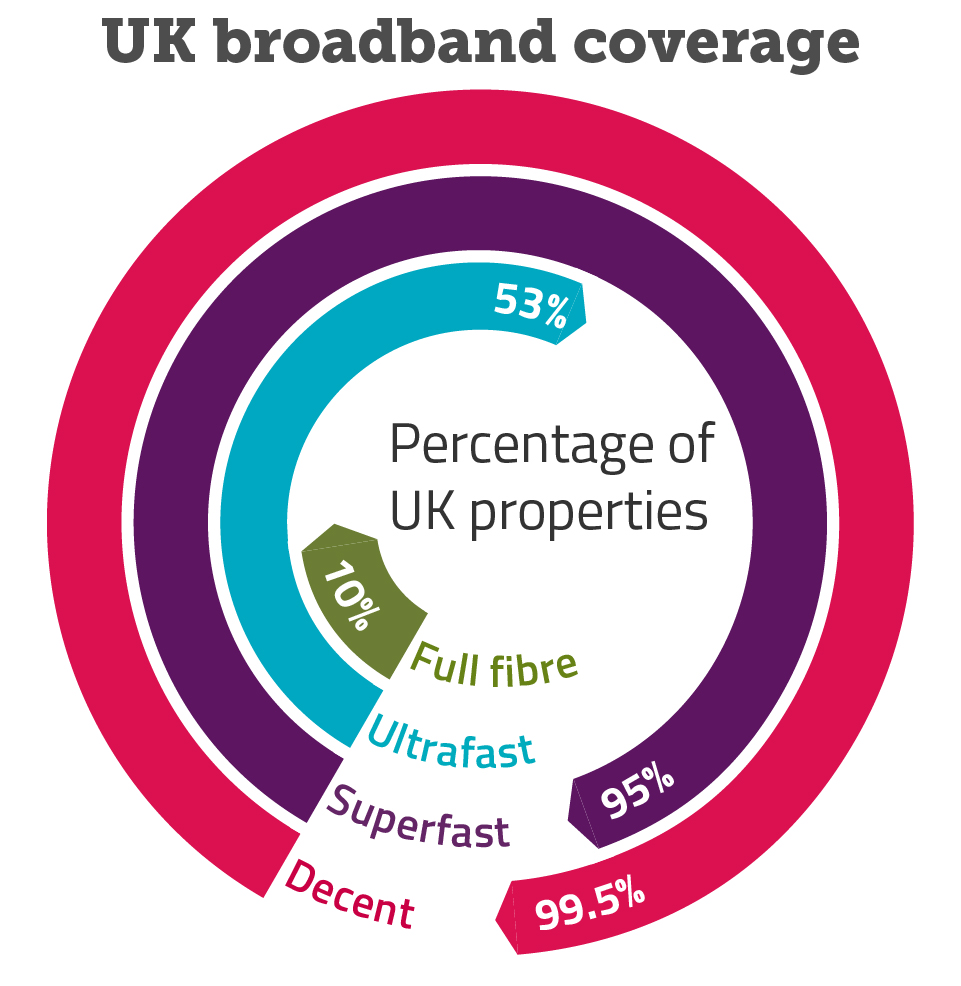20 December 2019
- Full-fibre broadband now available to around three million homes
- Some rural areas still behind towns and cities for broadband and mobile coverage
More people can get faster broadband and a good mobile signal than last year, but some rural areas are still behind towns and cities for coverage – new data from Ofcom shows.
Ofcom’s annual Connected Nations report analyses the availability of broadband and mobile services across the UK and its nations. This year’s report highlights further progress from industry in rolling out their networks, with the availability of full fibre increasing by 67% and all four mobile networks launching 5G.
Demand for getting online has also increased, with average monthly broadband data use going up from 240GB per connection in 2018, to 315GB in 2019 – the equivalent of watching up to four hours of HD video content a day.
But the report also reveals more work is needed to improve services in rural areas, where some customers experience slower speeds than those in towns and cities.
Faster fibre networks on the rise
Ultrafast broadband. Today’s report also shows more than half of homes (53%) can get ultrafast broadband – broadly in line with last year. These connections, which can be delivered over a combination of fibre and cable lines, offer download speeds of at least 300 Mbit/s.
Full-fibre broadband. Around three million homes (10%) can now get full-fibre broadband – which offers download speeds of up to one gigabit per second (1 Gbit/s). This has increased sharply from last year’s figure (6%), with 1.4 million extra homes now able to access the latest broadband technology. Northern Ireland has the highest full-fibre coverage of any UK nation, with nearly a third of homes (31%) able to receive it. Wales was also above the UK average, with 12% coverage.
Ofcom will shortly publish new plans to promote further investment in fibre networks – including in rural areas.
Millions could upgrade to faster broadband
Superfast broadband
The vast majority of homes (95%) can now access superfast broadband, which offers download speeds of at least 30 Mbit/s – sufficient for most households’ current needs. Take-up of superfast packages has climbed by a fifth in just one year – meaning that, for the first time, more than half (54%) of homes are subscribing to superfast services. But millions more could get faster internet by upgrading today, without paying more.[1]
Ofcom’s Boost Your Broadband website allows people to easily check which broadband services are available in their area and get advice on how to find the best deal for them.
Getting rural areas connected

Although faster broadband has reached many more rural premises in recent years, some are still unable to get a decent service. The Government defines decent broadband as a download speed of at least 10 Mbit/s, and an upload speed of at least 1 Mbit/s.
Currently an estimated 155,000 UK properties (0.5%) are unable to get decent broadband. This has fallen significantly from 677,000 last year (2%), due to the availability of wireless broadband services.[2] The majority of these will be in rural areas.
From March next year, homes and businesses still unable to get a decent broadband service will be legally entitled to request one under the Universal Service Obligation, which Ofcom is implementing on behalf of the Government.[3]
Mobile coverage improves, but more to do
In today’s smartphone society, being able to make calls and get online on the move is crucial to people’s personal and working lives. Today’s figures show 66% of the UK’s land area is covered by good 4G reception from all four networks. And 91% of the country can get reliable 4G from at least one operator.
But while most of the country can get coverage from at least one mobile company, there are stark differences in the level of choice available to customers in urban and rural areas. Ninety-six per cent of urban areas can get 4G reception from all four operators, compared to 62% of rural areas. 5% of the UK's landmass gets no mobile reception at all.[4]
However, rural mobile coverage is set to increase as a result of an industry project announced in October. Mobile operators have worked with Government and Ofcom on a plan to introduce a ‘shared rural network’. This will see high-quality 4G reach 95% of the UK by 2025, as mobile companies share their existing masts and invest in new sites. We have provided technical advice on the plans.
Leading the way in 5G
5G – the fifth generation of mobile technology – launched in the UK this year, with all four mobile networks rolling out 5G across a total of 40 UK towns and cities.
Initially, 5G will be an enhanced version of 4G – offering faster speeds, more capacity and far fewer connection delays. But in the longer term it can support a host of innovative new services for mobile users and businesses, from farming to factories.[5]
Yih-Choung Teh, Strategy and Research Group Director at Ofcom, said: “This year we’ve seen full-fibre broadband grow at its fastest ever rate, and all four mobile networks launch 5G.
“But despite this good progress, there is more to do to bring all parts of the country up to speed– particularly rural areas. So we’re working with industry and the Government to help bring better services to people who need them.”
Email Newsletters
Sign up to receive TelecomTV's top news and videos, plus exclusive subscriber-only content direct to your inbox.



